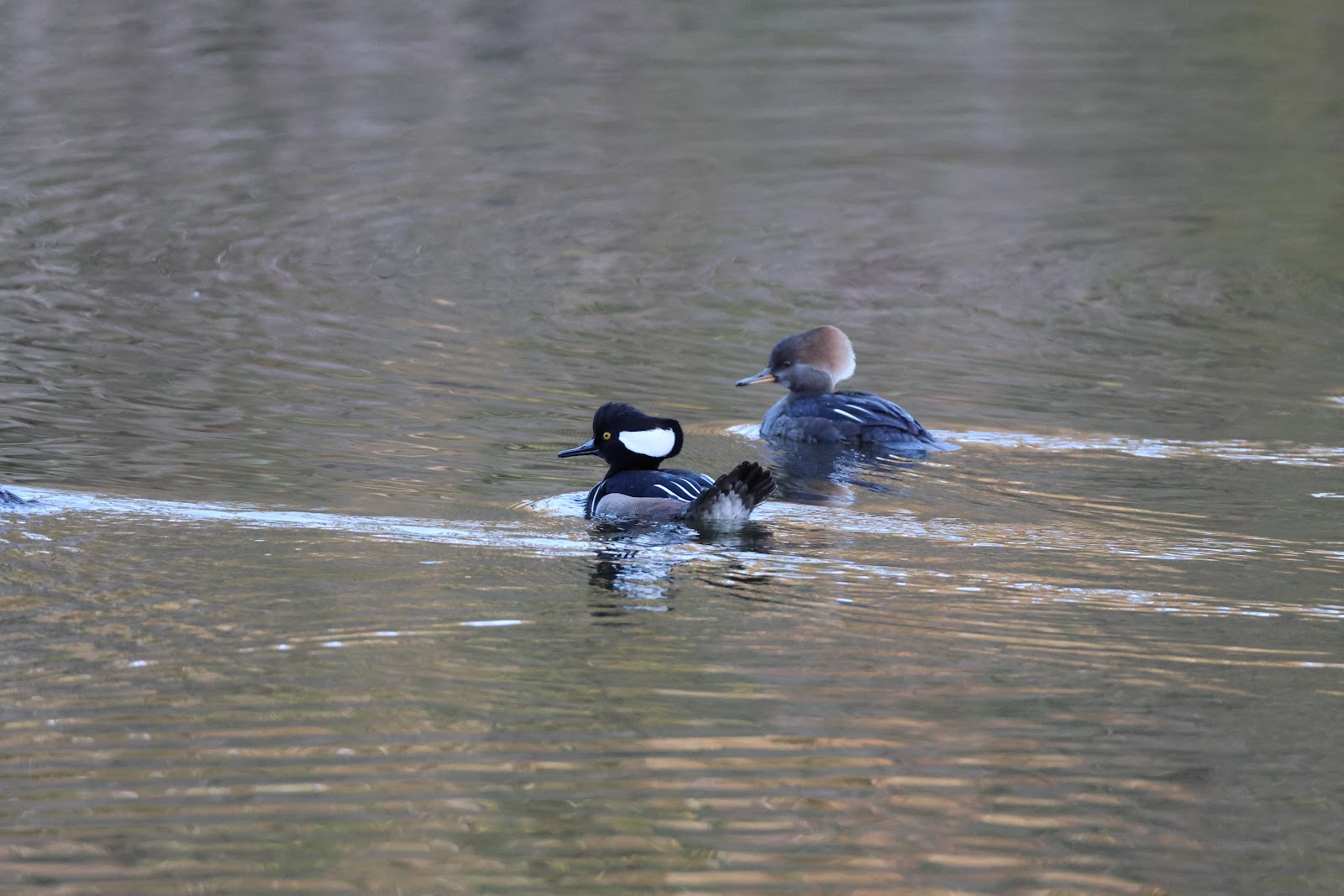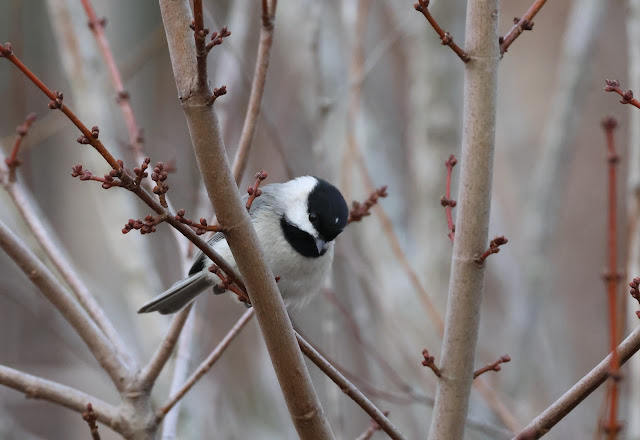First some local birds found before and after work during the week....
My Painted Bunting has come back after the holiday break and doesn't seem to be too annoyed that I let the feeder go empty while I was out West. Here he is sharing with a Chipping Sparrow.
A nice Lion's Mane mushroom is growing on an oak at Airlie Gardens but it is about 20 feet up and I doubt the staff would like me climbing it. My mouth is watering just looking at it each time I go.
A Lesser Scaup has been hanging around. The somewhat peaked head and dirty flanks are clues but the thin "nail" on the bill seals the deal.
Brown Thrashers shouldn't be taken for granted. What would this world be without them? I shudder to think.
It's fun to watch the sun dip below the horizon, but the real show usually begins once it has firmly set.
My buddy Henry had mentioned a family of Barred Owls hang out near the creekside trails in back of Wade so I went exploring and it didn't take long to find one.
Friday morning I woke early in anticipating of my Wake and Durham county road trip. I brought some change of clothes in case I decided to stay the night and set off by 5:30am.
First stop was at Eddie O's house in Cary to check out his long staying Rufous Hummingbird. Eddie has named him Esau, a character from the Hebrew Bible. For those of you out of the loop like me, here is an excerpt from Wikipedia:
Esau, a "man of the field", became a hunter who had "rough" qualities that distinguished him from his twin brother. Among these qualities were his redness and noticeable hairiness
Seems like a pretty good description for this interloper.
The challenge was getting pics with the paint splotch on the head somewhat concealed. Susan (our NC hummingbird expert and bander) puts a blotch of paint on the banded hummingbirds so that if another rufous shows up they can be distinguished from each other.
While Eddie and I chatted, I was able to get photos from many angles. Eddie is a super nice guy and exemplifies the awesome birding community in the triangle area which is the largest in NC and most robust. He not only invites anyone to come and see his hummingbird, he actually comes out and talks with everyone and gives some of the story about it. For example, its been coming since November and has fed from the feeder but more importantly is attracted to the flowering bush - Winter Honeysuckle (Lonicera fragrantissima). In fact, while I was there it fed exclusively from this non-native bush or from the insects attracted to it. This is the same type of Honeysuckle that hosted a Rufous Hummingbird at the Chapel Hill Coker Arboretum a while back.
Here are some quick facts about Cary from Wikipedia:
Cary is a town in Wake and Chatham counties in the U.S. state of North Carolina and is part of the Raleigh–Cary, NC Metropolitan Statistical Area. According to the 2020 Census, its population was 174,721, making it the seventh largest municipality in North Carolina, and the 148th largest in the United States.
The awesome thing about the triangle area is all the green spaces and parks they have. The red outline above is the limits of the municipality of Cary.
Eddie's little slice of heaven in his back yard was hard to leave but I had other places in Wake County that I was planning on visiting.
My next planned stop was Apex Community Lake Park in none other than Apex which is yet another town that is part of what I would call the triangle and is directly adjacent to Cary.
Apex municipality limits shown above in red with Apex Community Park in the dead center, only just within the boundary and only 5 minutes from Eddie's house in Cary.
Technically Research Triangle Park (RTP) is just a smaller area where all the research facilities are nested between the cities of Raleigh, Durham and Chapel Hill, hence the name the "triangle". However, over the years I have noticed when someone says they live in the Triangle or RTP, what they mean is they live in a town that is centered near RTP. I would consider both Apex and Cary to be in this boundary but its definitely not an official boundary and people that live in those towns may not agree. Here is the generally accepted boundary of what is RTP which is decidedly north and west of Apex and Cary:
My next target was a Nashville Warbler that has been hanging out next to the fishing pier at this lake park. Apex Community Park is just one more example of how towns in the Triangle have reserved the land around lakes as green spaces instead of building houses right up on them. This is what we should do with our coastal land as well instead of allowing filthy rich people to build right on the beach and limit access to the public. Don't get me wrong, I don't begrudge the few rich people that build unobtrusive houses on lakes, rivers and other bodies of water in a way that complements their surroundings. What I don't like are huge McMansions that obscure views and the people in them that usually fight to make the waterways private and exclusive.
It wasn't hard to find this warbler as he has been feeding in the bushes right at the base of the pier.
My buddy Steve met up with me at this point to bird with me and catch up in general. Steve just got hired on full time with Lindblad as a naturalist and boat operator/trainer. I met him previously on NC pelagics but really got to know him on my Antarctica trip where he was working as a naturalist. A stand up individual and fun to bird with. His ears are more reliable than mine and he was able to pick out some birds I didn't hear. Steve hails out of Chapel Hill which straddles Chatham, Orange and Durham counties but he was happy to help me explore some more hotspots in Wake County.
A quick stop at the famous Mid Pines Rd didn't bag me any year birds but its always worth a stop.
Winter Wren - at Lake Wheeler Marshes where we dipped on any good ducks but picked up some other year birds for me.
After loading up on meat, we headed to Prairie Ridge Ecostation which is a great little place run by the NC Museum of Natural Sciences. They keep it as an educational center but also open it to the public. The well stocked feeders are a big hit with the local birds.
White-crowned Sparrow - this individual was banded but unfortunately the band was turned the wrong way and I couldn't read it.
Steve and I bid adieu as the sun started to set and I headed to my last stop of Mason Farm in Chapel hill which is in the Durham County part of it. Mason Farm used to be the most popular birding spot but for some reason lost some of its luster to spots like Brumley which have taken on the mantle. It may be due to the sometimes difficult to cross stream that some smaller cars can't navigate at the entrance to the parking lot, or maybe a couple break ins are what did it. Those things don't bother me as my truck is a beast and I almost always carry my valuables with me.
I picked up this Red-headed Woodpecker before it got to dark for photography. I had to wait a good 25 minutes after sunset to hear the woodcocks and they were not really too excited, just a few peents here and there and some flight displays. I will try for pictures later this summer up in the mountains, but for now this checklist with a sound recording will have to do. Even if you are deaf, you will clearly see three Peents on the sonogram. I love modern technology sometimes.
That night I stayed at a Home2 Suites which coincidentally was the same one we stayed in for a week when we evacuated from Hurricane Florence. Here is the weird thing though, when we stayed there for a week, there was a time I distinctly remember when the fire alarm went off and the whole building had to file out while the fire department came. Well guess what happened again this time at 1am while I was in a deep sleep? You guessed it, a fire alarm and again the fire department came. Someone had overloaded a clothes washer and the engine burned out and caught fire or at least started smoking barely.
I somehow still managed to get up early enough to make it to Flat River Waterfowl Impoundments at first light. This was the real reason I came up to the Triangle area as I wanted to re-acquaint myself with some Evening Grosbeaks and this seemed like the only place that was public where people have seen them over the past couple years. What I didn't realize is that it was hunting season for small game and ducks and the place was crawling with yokels with shotguns and dogs. Never the less, its a beautiful place and its hard to believe so close to Durham the city.
Brown Creeper
At about the end of the gravel road I checked my Merlin App to see if any birds were calling that I could not hear. First it came up with Red Crossbill and then quickly Evening Grosbeak among more common birds. It also came up with Rock Bunting so obviously its not a perfect tool, but it at least alerted me to the possibility that Red Crossbills and Evening Grosbeaks might be around. I tried it several times again and got the Crossbills and Grosbeaks again. It is unlikely that the tool would screw up multiple times in succession so I started to look through all the cone trees.
Its great that we have had these Grosbeak irruptions a couple of years now but it makes you wonder what is going on in their normal boreal ranges. That being said, the old timers report that Evening Grosbeaks were somewhat common 50 years ago in NC. I eventually lost them as they moved around but found another group of 20 or so an hour later in another spot about a quarter mile away. I can't be sure if this was the same group or another one.
This awesome gameland in Durham County is just one gem among many in Wake and Durham counties and I hope to bring you some more stories and pics in the coming months.
The drive home was uneventful and I made it home early in the afternoon so I decided to stop by Blue Clay Bike Park in northern New Hanover County to check on the sparrow fields. It was late enough in the afternoon that sparrows were minimal but I did find some large flocks of robins and blackbirds. The cherry on top of my trip was this Hairy Woodpecker which are somewhat difficult to find in New Hanover.
Great times! I can't wait to explore the next NC county!


















































No comments:
Post a Comment